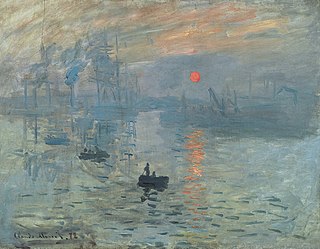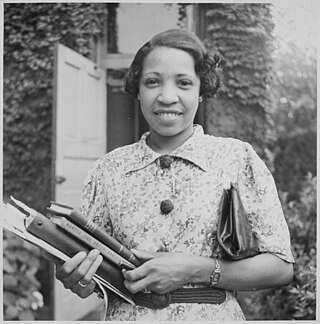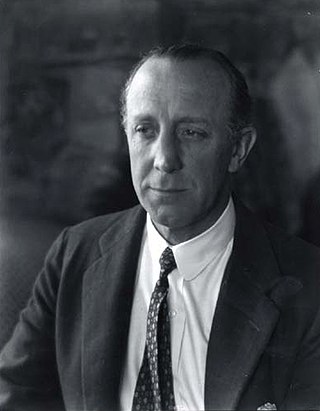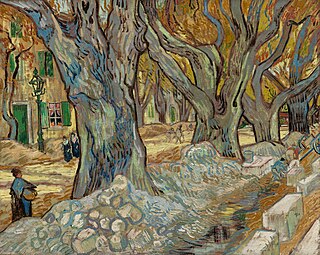Related Research Articles

Impressionism was a 19th-century art movement characterized by relatively small, thin, yet visible brush strokes, open composition, emphasis on accurate depiction of light in its changing qualities, ordinary subject matter, unusual visual angles, and inclusion of movement as a crucial element of human perception and experience. Impressionism originated with a group of Paris-based artists whose independent exhibitions brought them to prominence during the 1870s and 1880s.

Henri-Edmond Cross, born Henri-Edmond-Joseph Delacroix, was a French painter and printmaker. He is most acclaimed as a master of Neo-Impressionism and he played an important role in shaping the second phase of that movement. He was a significant influence on Henri Matisse and many other artists. His work was instrumental in the development of Fauvism.

The Phillips Collection is an art museum founded by Duncan Phillips and Marjorie Acker Phillips in 1921 as the Phillips Memorial Gallery located in the Dupont Circle neighborhood of Washington, D.C. Phillips was the grandson of James H. Laughlin, a banker and co-founder of the Jones and Laughlin Steel Company.

Lois Mailou Jones (1905–1998) was an artist and educator. Her work can be found in the collections of the Smithsonian American Art Museum, The Metropolitan Museum of Art, the National Museum of Women in the Arts, the Brooklyn Museum, the Museum of Fine Arts, Boston, Muscarelle Museum of Art, and The Phillips Collection. She is often associated with the Harlem Renaissance.

Albert Dubois-Pillet was a French Neo-impressionist painter and a career army officer. He was instrumental in the founding of the Société des Artistes Indépendants, and was one of the first artists to embrace Pointillism.

Luncheon of the Boating Party French: Le Déjeuner des canotiers is an 1881 painting by French impressionist Pierre-Auguste Renoir. Included in the Salon in 1882, it was identified as the best painting in the show by three critics. It was purchased from the artist by the dealer-patron Paul Durand-Ruel and bought in 1923 from his son by industrialist Duncan Phillips, who spent a decade in pursuit of the work. It is now in The Phillips Collection in Washington, D.C. It shows a richness of form, a fluidity of brush stroke, and a flickering light.

William Langson Lathrop was an American Impressionist landscape painter and founder of the art colony in New Hope, Pennsylvania, where he was an influential founder of Pennsylvania Impressionism.

Soren Emil Carlsen was an American Impressionist painter who emigrated to the United States from Denmark. He became known for his still lifes. Later in his career, Carlsen expanded his range of subjects to include landscapes and seascapes as well.

Marjorie Acker Phillips was an American Impressionist painter and art collector. She co-founded the Phillips Collection with her husband, Duncan Phillips.

Paul Hampden Dougherty was an American marine painter. Dougherty was recognized for his American Impressionism paintings of the coasts of Maine and Cornwall in the years after the turn of the 20th century. His work has been described as bold and masculine, and he was best known for his many paintings of breakers crashing against rocky coasts and mountain landscapes. Dougherty also painted still lifes, created prints and sculpted.

The terms California Impressionism and California Plein-Air Painting describe the large movement of 20th century California artists who worked out of doors, directly from nature in California, United States. Their work became popular in the San Francisco Bay Area and Southern California in the first three decades after the turn of the 20th century. Considered to be a regional variation on American Impressionism, the California Impressionists are a subset of the California Plein-Air School.

The Magpie is an oil-on-canvas landscape painting by the French Impressionist Claude Monet, created during the winter of 1868–1869 near the commune of Étretat in Normandy. Monet's patron, Louis Joachim Gaudibert, helped arrange a house in Étretat for Monet's girlfriend Camille Doncieux and their newborn son, allowing Monet to paint in relative comfort, surrounded by his family.

The depiction of winter landscapes in Western art begins in the 15th century. Wintry and snowy landscapes are not seen in early European painting since most of the subjects were religious. Painters avoided landscapes in general for the same reason. The first depictions of snow began to occur in the 15th and 16th centuries. Paintings that feature snow as a theme are mostly landscapes, even if some of these works involve religious or even fantasy landscapes. Most of these winter landscapes in art history are plein-air depictions of winter scenes, using the quality of gray winter light to create the special winter atmosphere. Depiction of snow in Europe is essentially a northern European theme.

Skaters in the Bois de Boulogne is an oil-on-canvas landscape painting by the French artist Pierre-Auguste Renoir, created during the winter of 1868. The painting depicts a snowscape with many Parisians, young and old, spending leisure time on a frozen park lake. Due to Renoir's strong dislike of cold temperatures and snow, the piece is one of his few winter landscapes.

Walter Elmer Schofield was an American Impressionist landscape and marine painter. Although he never lived in New Hope or Bucks County, Schofield is regarded as one of the Pennsylvania Impressionists.
Sandra S. "Sandy" Phillips is an American writer, and curator working in the field of photography. She is the Curator Emeritus of Photography at the San Francisco Museum of Modern Art. She joined the museum as curator of photography in 1987 and was promoted to senior curator of photography in 1999 in acknowledgement of her considerable contributions to SFMOMA. A photographic historian and former curator at the Vassar College Art Gallery in Poughkeepsie, N.Y., Phillips succeeded Van Deren Coke as head of one of the country’s most active departments of photography. Phillips stepped down from her full time position in 2016.

The Red Cape, also sometimes known as Madame Monet or The Red Kerchief, is an oil-on-canvas snowscape by French impressionist Claude Monet. The painting depicts Claude Monet's wife, Camille, passing outside of a window dressed in a red cape.

The Road in Front of Saint-Simeon Farm in Winter is an 1867 oil-on-canvas snowscape painted by French impressionist Claude Monet. It depicts a snow-covered road in front of a barn, with tracks of a horse cart and various footsteps in the snow. The painting is one of four related works from the winter of 1867, and represents Monet’s earliest series. They include this work, followed by Road to the Farm, Saint-Siméon, Honfleur, Road in Front of Saint-Siméon Farm in Winter, and Cart on a Snowy Road at Honfleur.

The Large Plane Trees, also called Road Menders at Saint-Rémy is an oil painting by Vincent van Gogh. Painted in 1889 in Saint-Rémy, France, the painting depicts roadwork underneath autumn trees with yellow leaves. In actuality, "The Large Pane Trees" and the "Road Menders of Saint-Rémy" are two different paintings and are sometimes confused as one. Van Gogh painted "The Large Plane Trees" first on a red and white checkered table cloth. He later returned and painted it again on an art canvas.
Agnes Millen Richmond (1870–1964) was an American Impressionist painter based primarily in New York City, New York. Her body of work consists primarily of oil paintings of confrontational, confident women, as well as a few landscapes and paintings of other subjects.
References
- Baker, Kenneth. (1999). That's Cold! Exhibition shows how much feeling and structure impressionists packed into winter canvases. San Francisco Chronicle. Retrieved September 30, 2012.
- Dobrzynski, Judith H. (1999). "Travel Advisory; Snow Will Cover Walls in Brooklyn in Summer". The New York Times, May 23.
- Moffett, Charles S. (1999). Impressionists in Winter: Effets de Neige. Phillips Collection. ISBN 0856674958.
- Myers, Chuck (1998). "Winter Wonderland(scapes)". Chicago Tribune.
- Rathbone, Eliza E. (1999). "Snowy Landscapes". Southwest Art 28 (10). ISSN 0192-4214. (subscription required)
- Richard, Paul (1998). "At the Phillips, a Midwinter Day's Dream". The Washington Post. Retrieved April 14, 2012. (subscription required)